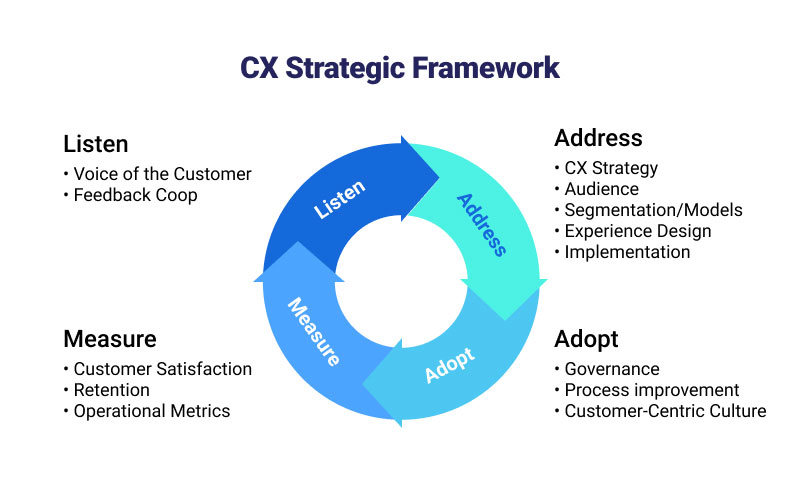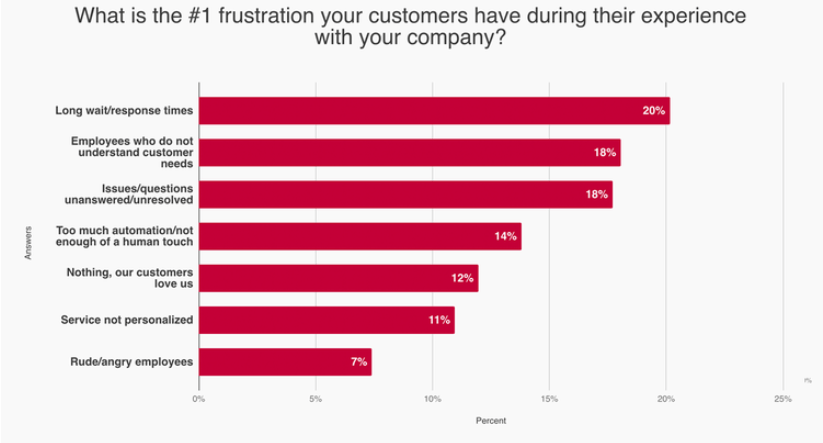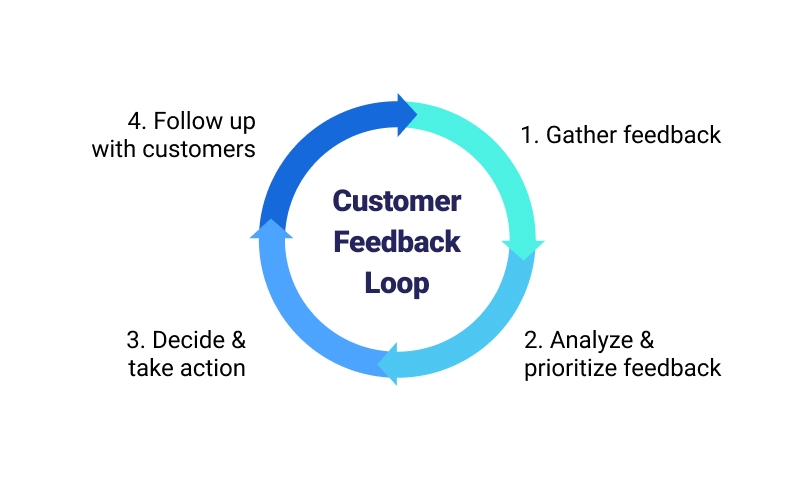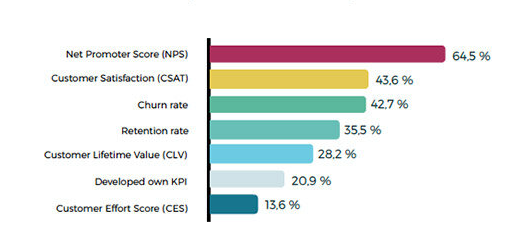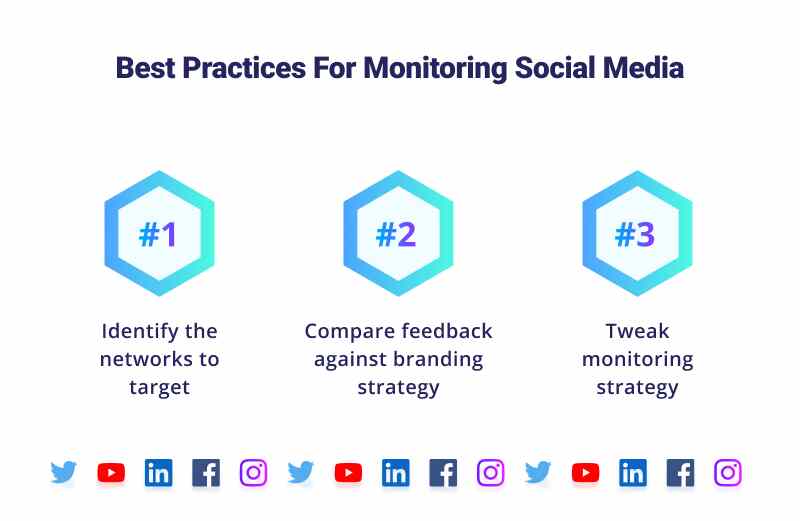12 Effective Customer Experience Best Practices & Tips
- February 17, 2021
- 16 mins read
- Listen
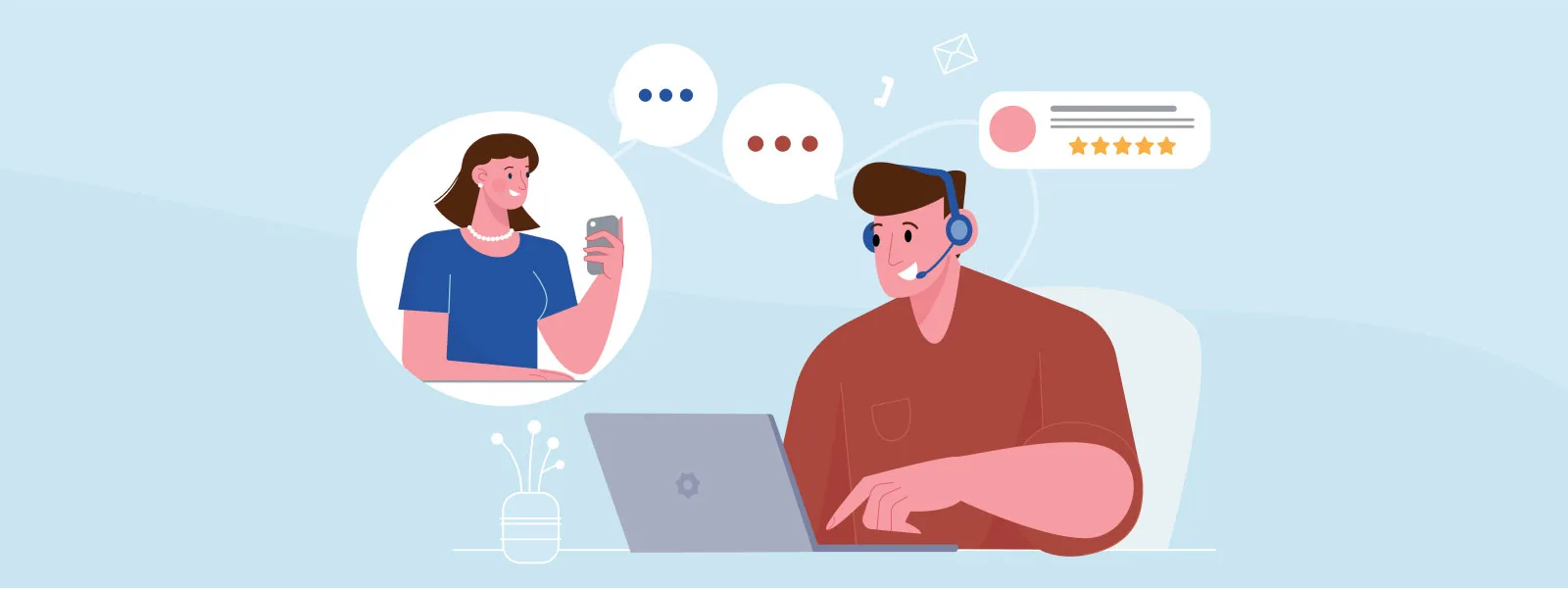
Table of Content
Customer-centricity is synonymous with successful businesses, especially as markets are saturated with more choices than ever. Customers are demanding more, and only businesses that adapt to customer-centric processes will survive such a volatile market.
64% of companies with a customer-focused CEO believe they are more profitable than their competitors.
It is important to give your clients an exceptional service experience across each touchpoint to prove yourself customer-obsessed. For that, you need to have a solid customer experience strategy in place and build customer experience best practices to be followed across all customer interactions.
For a CX transformation to be a success, you need a clear vision, robust strategy, carefully created solutions, and follow the customer experience tips wisely. Prior you have a focus on building a strategic CX framework.
The digital customer experience framework ideally comprises four important aspects. CX doesn’t happen at one singular point in time. All four stages are vital throughout the client’s journey, and all need to be addressed in any strategy.
Here are 4 suggestions on how to fine-tune the experience at each level.
- Listen to your target audience to understand their needs & expectations
- Address and engage customer queries in real-time
- Focus on building a customer-centric strategy
- Measure customer satisfaction by identifying the right metrics
Based on the customer experience framework, here are the customer experience strategy best practices.
Key Best Practices and Tips to Deliver an Exceptional Customer Experience
Without an authentic customer-centric culture, a business leaves itself vulnerable to its competition. Moreover, there will be a negative impact on customer lifetime value (CLTV) and retention rates. Keep a tab on the best practices and follow the tips to create great customer experience examples.
Here is a list of best practices that can help businesses to increase customer experience significantly.
- Build customer-centric strategy
- Provide real time response
- Use the right tools to enhance customer experience
- Create a customer feedback loop
- Streamline your sales processes
- Evaluate your customer experience metrics
- Monitor social listening
- Conduct regular team training
- Strengthen customer communication skills
- Deliver consistent CX across every touchpoint
- Follow Up with your customers
- Create loyalty program
Let us dive into a comprehensive discussion on the tips and best practices that can help businesses to make a strong impact on customer experience.
#1. Build Customer-centric Strategy
Customer experience is the sum-total impact of all interactions during a customer lifecycle.
However, it differs from business to business.
For B2B business, it means brand discovery, sales experience, onboarding, and product experience. In the B2C context, it applies to every interaction from the ads and social media interactions, from the content experience to online or in-store buying experience and everything that comes before or after.
Whether B2B or B2C, when it comes to CX, every function, team, channel, and platform, has an important role play in delivering a good experience. Hence, you need to build a customer-centric culture to deliver on your CX strategy. It’s equally important to understand the difference between the customer journey vs buyer journey to ensure right steps in boosting the overall experiences.
Key customer experience tips
- Anticipate your customer needs – Understand what your customers are looking for and align your services to meet their expectations.
- Collect customer feedback – Ensure to obtain feedback from the customer interactions made across all touchpoints such as social, chat, in-app, etc.
- Be easily accessible – Make sure that you are easy to access and answer customer questions promptly.
- Offer proactive customer service – Proactive customer service gives your customers resources that help them solve problems on their own, without having to reach out to your business for support.
#2. Provide Real time assistance
63% of consumers reported that they are more likely to return to a website that offers real-time support.
Delay in response impacts customer satisfaction (CSAT) scores and risks your business with consequences like negative reviews, bad word of mouth, etc. Hence, real-time response is extremely crucial when it comes to quality customer support.
Customer response time is a key factor for clients to decide which business they will continue to engage with.
Key customer experience best practices for handling response time
- Implement live chat software – Live chat helps to address your customer queries in real-time. Maximum consumers say the number one factor that leads to a great customer service experience is having their issues resolved quickly.
- Deploy chatbots to engage customers 24×7 – Deliver instant response to customer queries round the clock by automating your repetitive customer support tasks with AI chatbots.
- Engage customers in real-time – Leverage visual engagement tools like co-browsing, voice & video chat that help in quick identification of the issue and improve chances of first response time.
- Create a comprehensive knowledge base- It allows your customers to help themselves by giving them access to immediate knowledge without requiring personal assistance.
#3. Use the Right Tools to Enhance Customer Experience
In order to align your services to match customer expectations, it is very important to invest in the right technology and tools. It is one of the customer experience best practices that need to be focused on by every business.
Identifying the right tools and deploying them will help to encourage customers to have greater interaction with your brand. However, the end goal is to fulfill customer expectations and make them feel happy.
Businesses that are customer-focused should add digital tools along with the traditional ones to engage customers. The tools will help to monitor customer behavior and take proactive actions. They also help to handle customer complaints faster and provide effective solutions.
Key customer experience tips for customer experience management:
- Invest in customer engagement tools like co-browsing, video chat, chatbots to collaborate with customers in real-time and guide them through the complex process. Identify issues faster and deliver effective solutions through personalized chat that improves customer experience.
- Use tools to collect customer feedback from your customers. It gives you the best insight into their journey, so you can fix it before they leave.
- Implement tools to gain better insights and analytics to pull information from every point in your customers’ experience. Create customized dashboards with key metrics you know impact higher churn.
#4. Create a Feedback Loop
Most companies ask customers for feedback, but when it comes to closing the loop on that feedback, most still use rudimentary strategies, like sending “Thank you, we received your feedback”.
Building a feedback loop involves gathering information from customers, analyzing the data, and applying the final outcomes to the product. The feedback loop helps businesses to gain an advantage over the competition, creating a high-quality digital customer experience people will always remember.
Having a customer feedback loop is one of the most effective ways to improve your products or services in accordance with your customers’ satisfaction. The loop allows you to acquire, evaluate and apply the users’ suggestions in order to enhance your offers.
Key customer experience tips for building a customer feedback loop
- Use customer feedback loop to identify unhappy customers to plan the right way to engage and convert them into happy customers.
- You can automate your feedback systems to make the process of data collection and analysis easier.
- The feedback loops have a great benefit to interpreting and analyzing customer feedback because these systems are similar to many survey tools.
#5. Streamline Your Sales Processes
Not having a well-defined sales process can put you in a haphazard situation. Usually, the sales team encounters a number of queries from potential customers before they make their final decision.
Hence, you have to consider your sales tasks as well as your customer success processes as one of the CX best practices.
The common issues that your sales team might face are providing timely, accurate responses to highly-specific questions and keeping the customers engaged on a regular basis. It is important to streamline your sales process to both handle the increased chats, and better qualify leads.
Key customer experience tips to improve the efficiency of your team
- Outline steps clearly that your sales team will take from the conversion until after the lead is closed.
- Implement training to set up and review these steps to ensure that the entire team is on the same page.
- Deploy chatbots to automate common sales queries to engage customers 24×7 when the sales team is busy.
- Automate the lead qualification with bots by asking sales questionnaires to get good quality leads.
- Use social platforms efficiently as they provide opportunities to “meet” customers, engage with them and introduce them into your sales funnel.
#6. Evaluate Your Customer Experience Metrics
It is essential to measure the impact of your customer experience strategy. Evaluating the CX metrics is not just to measure your ROI at an organizational level, but to understand which strategy is contributing most to increasing customer experience. There are many ways to understand customer intent, churn potential, and level of satisfaction.
The below image shows the important customer experience metrics to need to be measured.
You can use a post-service customer effort score (CES) survey to understand the positive, neutral or negative customer experience during an interaction with your brand or the net promoter score (NPS) survey auto-deployed across customer touchpoints of interaction with the “likelihood to recommend” question is scored on a simple zero-to-ten scale.
You can set a quarterly CSAT questionnaire as an essential element of your CX program to gauge how your customers feel about your organization and help to determine your best practices. It also helps you to find what areas of your business require improvement.
No matter which method you deploy, the bottom line is you need to know customer satisfaction levels and have a systematic way to identify potential detractors or customers displaying churn intent. A successful business knows how to prioritize because every business has limited resources to invest.
Key customer experience best practices
- Identify the right customer experience metrics and KPIs that fit your business objectives to measure client satisfaction efficiently.
- Select a benchmark you want to achieve and build your CX framework to fulfill the defined KPI.
- Conduct regular surveys as it is a crucial step for building a successful customer experience management approach. You can better assess which levers to pull to influence the happiness of your customer.
- Measure your customer experience after every conversation, call, or successful checkout through NPS surveys.
#7. Monitor Social Listening
79% of consumers expect a response within the first 24 hours after reaching out to a brand on social media, and 40% expect brands to respond within an hour.
Social listening can be an effective part of a brand’s customer service efforts and can play a valuable role in determining if its customer’s needs are being fulfilled, which also helps to improve the customer experience.
Focusing on social listening allows brands to know what their customers are talking about on Facebook, Twitter, Instagram, and other social networks. They also know how they feel about the brand, help them to discover the pain points in the customer journey, and obtain actionable insights that will help them to improve the customer experience.
Key customer experience tips for effective social listening
- Prepare an outline exactly to monitor and create a list of terms like brand name, hashtags, industry keywords.
- Set up a social listening system to track and monitor the conversations easily by using a variety of tools like Hootsuite, Google Alerts, etc.
- Create plans for how teams should respond to certain types of comments. Train your team to mitigate complaints as well as engage with positive comments and feedback.
- It is important to monitor social mentions and customer reviews. You need to be quick to respond when concerns are raised.
- Respond quickly as it shows customers you care and when they know this, they’re more likely to be loyal.
#8. Conduct Regular Team Training
A knowledgeable team is the backbone of every business. And a shortcut to making the team well educated and informed is through training. Training is very important for the customer service reps to understand the products and services while communicating with customers.
Adequate knowledge ensures that agents can communicate effectively and enthusiastically, building trust and confidence in customer relationships. It also means they can answer questions on the spot and overcome common customer objections.
Customer experience best practices to be followed for effective training
- Train your team to practice active listening to understand customer needs to provide effective solutions.
- Use role-plays, simulations, and other techniques to provide opportunities for agents to apply their product knowledge in real-life situations.
- Ensure every employee gets the same high standard of product & service training to be able to handle complicated queries with the right tools.
- Training should be easily accessible for your employees as well as motivating. They should feel encouraged to gain product knowledge.
#9. Strengthen Customer Communication Skills
Fostering effective customer communication skills should be an integral part of the company’s values. Improving the ways on how to communicate helps to promote your brand to future customers, build strong client relationships, and address customer concerns.
Good communication skills are one of the most important traits for improving the bottom line of every business. Whether it is internal or external communication, you should be able to communicate flawlessly to make it effective.
Key customer experience tips for enhancing customer service communication
- Focus on delivering a first great experience by delivering real-time support and avoiding scripting conversations.
- Measure your customer communication metrics like first response time (FRT), average resolution time (ART) omniregularly.
- Acquire customer feedback after every conversation to improve your communication skills.
- Practice customer service etiquette like active listening, using positive words, avoiding technical jargon, etc.
#10. Deliver Consistent CX Across Every Touchpoint
Customers interact with businesses across multiple channels, which can be websites, social media, email, and more. However, while customers may accept service from different channels, they expect that the communication remains consistent.
The number of companies investing in the omnichannel experience has jumped from 20% to more than 80%.
Recent omnichannel retailing research provides evidence that consistent customer experience is the customer’s evaluative judgment of the consistency of the retailer’s product availability and pricing across any channels.
It can be challenging, but the best example here is IKEA. Visit an IKEA store around the world and you will get the same experience as it invests heavily into the customer experience. This year alone, they’ve opened more stores, invested in its home delivery network, and launched a brand new app – all to the benefit of their customer.
Their efforts to pay off have been huge! IKEA’s annual revenues have now reached more than $40 billion worldwide. And it is such results that are driving more companies to invest in omnichannel customer experience.
Key customer experience best practices
- Map your customer journey and follow the maps to understand your customer behavior across their buying journey
- Identify the channels that are most preferred by customers to reach out to you. Consider both digital and traditional customer communication channels.
- Create a strategy to engage customers across the identified touchpoints by using tools like live chat, visual tools, chatbot along with human support.
#11. Follow Up with Your Customers
Acquiring new customers is crucial to the growth and success of your business. But entrepreneurs shouldn’t forget there is huge potential for revenue in their list of existing customers.
Intelligent follow-ups at the right times can have a very powerful impact on your prospective clients, and keep you at the top of their mind while choosing between different service providers.
Practicing a well-planned follow-up strategy is a great way to boost the customer experience as well as revenues by selling more to existing customers and by getting referrals to new customers.
Note: Following up doesn’t always have to be sales-oriented. In fact, in most of your initial meetings, the focus should be on resolving the client’s problems and fulfilling their needs instead of closing the deal.
Key customer experience tips to create a follow-up strategy
- Send a thank-you note in the invoice or email to say thanks after making a sale as part of making it a good experience for your client.
- Check in with your clients a week or two after the sale and find out how everything is going. Are they happy with their purchase?
- Follow-up can be offering additional advice on how the prospect’s problems can be resolved effectively. Just offer solutions that can cause an immediate impact by sending research articles, eBooks links, or other resources that can increase their understanding of the issue.
#12. Create Loyalty Program
Keeping your existing customers on board is really a tough task. An easy hack to this is to blend your marketing strategies with innovative customer loyalty programs. It will help in increasing customer engagement, boost satisfaction and drive conversions.
From airlines offering frequent-flier deals to telecommunications companies lowering their fees to get more volume, brands are spending millions of dollars developing and implementing rewards programs.
Businesses benefit from customer loyalty programs in many ways. The primary objective is to retain existing customers by encouraging them to buy more.
For example, Starbucks Rewards incentivizes loyalty by rewarding customers with free drinks and food (flagship items), not with t-shirts and hats (which would be a nice gesture, but not what customers come to Starbucks for).
Key tips & best practices for aligning loyalty program strategy with your business strategies
- Offer value through your program. Make sure your customers see your loyalty program as worth joining, by offering something of value.
- Promote your loyalty program well and easily accessible to find for your customers.
- Make customers feel like VIPs by rolling out the red carpet for your loyal customers with creative perks like free coupons, points, free shipping upgrade, early access, etc.
Final Thoughts
Customer expectations are rising and as they have become more empowered, the importance of the customer experience best practices and tips cannot be underlooked. CX is an important area that needs attention and continuous nurture as it eventually helps you to create brand advocates who share their successful experiences with positive word of mouth.
If you as a business are focusing on being responsive, convenient, cheaper, and offering a more personalized experience or a better-quality product than your competitors, your customers will share your products or services without having to be encouraged to do so. A greater focus on customer experience methodology and framework will give your company the benefit of customer loyalty, higher retention, and growth in revenue.

